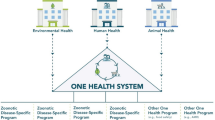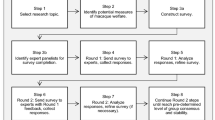Abstract
Animal research regulatory agencies have issued updated requirements for emergency response planning by regulated research institutions. A thorough emergency response plan is an essential component of an institution's animal care and use program, but developing an effective plan can be a daunting task. The author provides basic information drawn from the field of emergency management about best practices for developing emergency response plans. Planners should use the basic principles of emergency management to develop a common-sense approach to managing emergencies in their facilities.
This is a preview of subscription content, access via your institution
Access options
Subscribe to this journal
We are sorry, but there is no personal subscription option available for your country.
Buy this article
- Purchase on Springer Link
- Instant access to full article PDF
Prices may be subject to local taxes which are calculated during checkout



Similar content being viewed by others
References
Institute for Laboratory Animal Research. Guide for the Care and Use of Laboratory Animals 8th edn. (National Academies Press, Washington, DC, 2011).
Animal Welfare Act Regulations. CFR 9, Parts 2 and 3. Handling Animals; Contingency Plans.
Department of Homeland Security. National Incident Management System. December 2008 (FEMA, 2008).
FEMA. Animals in Disasters: Awareness and Preparedness. (FEMA Emergency Management Institute Independent Study Course No. IS-10A, 2010). http://training.fema.gov/EMIWeb/IS/courseOverview.aspx?code=IS-10.a.
Vogelweid, C.M., Hill, J.B. & Shea, R.A. in Planning and Designing Research Animal Facilities 1st edn (Hessler, J.R. & Lehner, N.D.M., eds) 135–149 (Elsevier, Burlington, MA, 2009).
Goodwin, B.S. Jr. & Donaho, J.C. Tropical storm and hurricane recovery and preparedness strategies. ILAR J. 51, 104–119 (2010).
Arms, M.M. & Van Zante, J.D. Wildfire evacuation: outrunning the witch's curse—one animal center's experience. ILAR J. 51, 158–163 (2010).
Schub, T. The year of the flood: Tropical Storm Allison's impact on Texas Medical Center. Lab Anim. (NY) 31, 34–39 (2002).
Heath, S.E. Disaster planning for research and laboratory animal facilities. Animal Welfare Information Center Bulletin 11, 2000. http://www.nal.usda.gov/awic/newsletters/v11n1/11n1heat.htm.
Vogelweid, C.M., Hill, J., Shea, R., Truby, S. & Schantz, L. Using site assessment and risk analysis to plan and build disaster-resistant programs and facilities. Lab Anim. (NY) 32, 40–44 (2003).
Vogelweid, C.M. in Management of Laboratory Animal Care and Use Program (eds. Suckow, M.A., Douglas, F.A. & Weichbrod, R.H.) 325–338 (CRC Press, Boca Raton, FL, 2002).
FEMA. Introduction to Incident Command System (ICS-100) (FEMA Emergency Management Institute Independent Study Course No. IS-100.b, 2010). http://training.fema.gov/EMIWeb/IS/courseOverview.aspx?code=IS-100.b.
FEMA. National Incident Management System (NIMS): An Introduction (FEMA Emergency Management Institute Independent Study Course No. IS-700, 2008). http://training.fema.gov/EMIWeb/IS/courseOverview.aspx?code=IS-700.a.
FEMA. Animals in Disasters: Community Planning. (FEMA Emergency Management Institute Independent Study Course No. IS-11a, 2010). http://training.fema.gov/EMIWeb/IS/courseOverview.aspx?code=IS-11.a.
Acknowledgements
I thank Eric Evans, Emergency Management Specialist at the MU Fire and Rescue Training Institute, for his insightful comments and review of this manuscript.
Author information
Authors and Affiliations
Corresponding author
Ethics declarations
Competing interests
The author declares no competing financial interests.
Rights and permissions
About this article
Cite this article
Vogelweid, C. Using principles from emergency management to improve emergency response plans for research animals. Lab Anim 42, F1–F7 (2013). https://doi.org/10.1038/laban.331
Received:
Accepted:
Published:
Issue Date:
DOI: https://doi.org/10.1038/laban.331



